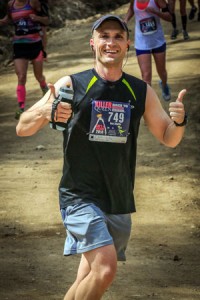Robie Creek is billed as the toughest half marathon in the northwest, 8.5 miles and up 4.6 miles down. This year the weather was beautiful, but hot! Temperatures approached 80 degrees. This was my first time running this particular race and utilizing a high intensity interval training (HIIT) and low running mileage to train for a distance effect. Racing Robie Creek taught me this:
- High intensity interval training (HIIT) combined with low running mileage can be a successful way to training for a very intense half marathon. (See my TrainingPlan PDF.)
- CrossFit as a form of high intensity training (HIT) is a good way to train your legs to handle a very fast and steep decent. When running downhill, your leg muscles work more in an eccentric or lengthening fashion versus the typical concentric or shorting fashion. This results in more tissue micro tearing and muscle soreness when running downhill and injuries more frequently. CrossFit training prepared my legs to handle the strenuous downhill section.
- Warm temperatures are great for fans and tough on participants. With an April event, most of my training was in cool weather, but the race was in much warmer weather. This was hard on me and other participants as there were many runners who were taken off the course with heat exhaustion. Of all the race factors, the temperature was the most problematic for me. I would highly advise at least a two week acclimatization period if you’re going from cool to warm weather. Next year, I will spend at least two weeks with daily sauna exposure prior to running. I will likely over dress during outdoor sunny training days to get my body used to higher temperatures.
- Train for the mid pack. In larger races or in races where there is not time corrals to help insure similar running paces, I would recommend training for this variable. Constantly changing your running pace faster or slower is more tiring than just running your preferred pace. This was the case for almost the entire race (and particularly the first five miles). One easy and effective running style to train for this variable is called the Fartlek. Fartlek is Swedish for “speed play”. It involves taking your normal forty to sixty minute run (after warm up) and intermittently changing pace from jogging (at different speeds) to sprinting. This can be performed in a structured form or randomly in true Fartlek style. One method is to pick objects in front of you and vary your running speed as you approach them. This is a critical training method if you want to improve your race time, and I should have incorporated Fartlek in my training to help prepare for Robie Creek.
- You need to know how you feel in what you wear BEFORE the race. You don’t want to have chaffing on your thighs for many miles even if you look good wearing new clothes. Try out everything you plan on wearing and have a backup plan for any potential problems. (Lansinoh works great as a soothing salve for all those chaffed areas.)
 Robie Creek is a nicely organized and challenging run. The scenery is beautiful, and course terrain makes it a unique race. I would highly recommend this race for anyone looking for a new challenge in the half marathon distance.
Robie Creek is a nicely organized and challenging run. The scenery is beautiful, and course terrain makes it a unique race. I would highly recommend this race for anyone looking for a new challenge in the half marathon distance.
Robie Creek was a great race and a fantastic teacher. I will be sure to incorporate more of these lessons learned when training for future races. I also plan on experimenting more with high intensity training as a means to prepare for other events.
I would love to hear about the lessons and experiences you have learned either at Robie Creek or other races!

Proud of you Ben.